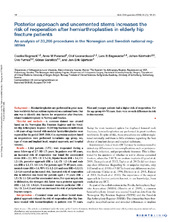| dc.description.abstract | Background — Hemiarthroplasties are performed in great numbers worldwide but are seldom registered on a national basis. Our aim was to identify risk factors for reoperation after fracturerelated hemiarthroplasty in Norway and Sweden. Material and methods — A common dataset was created based on the Norwegian Hip Fracture Register and the Swedish Hip Arthroplasty Register. 33,205 hip fractures in individuals > 60 years of age treated with modular hemiarthroplasties were reported for the period 2005–2010. Cox regression analyses based on reoperations were performed (covariates: age group, sex, type of stem and implant head, surgical approach, and hospital volume). Results — 1,164 patients (3.5%) were reoperated during a mean follow-up of 2.7 (SD 1.7) years. In patients over 85 years, an increased risk of reoperation was found for uncemented stems (HR = 2.2, 95% CI: 1.7–2.8), bipolar heads (HR = 1.4, CI: 1.2–1.8), posterior approach (HR = 1.4, CI: 1.2–1.8) and male sex (HR = 1.3, CI: 1.0–1.6). For patients aged 75–85 years, uncemented stems (HR = 1.6, 95% CI: 1.2–2.0) and men (HR = 1.3, CI: 1.1–1.6) carried an increased risk. Increased risk of reoperation due to infection was found for patients aged < 75 years (HR = 1.5, CI: 1.1–2.0) and for uncemented stems. For open surgery due to dislocation, the strongest risk factor was a posterior approach (HR = 2.2, CI: 1.8–2.6). Uncemented stems in particular (HR = 3.6, CI: 2.4–5.3) and male sex increased the risk of periprosthetic fracture surgery. Interpretation — Cemented stems and a direct lateral transgluteal approach reduced the risk of reoperation after hip fractures treated with hemiarthroplasty in patients over 75 years. Men and younger patients had a higher risk of reoperation. For the age group 60–74 years, there were no such differences in risk in this material. | en_US |

